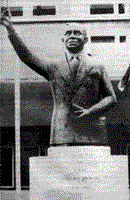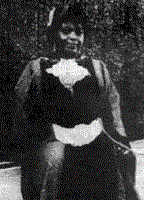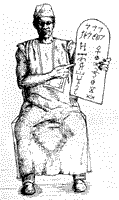ISAAC
THEOPHILUS AKUNA WALLACE-JOHNSON I. T. A. Wallace-Johnson led
the first mass movement of Sierra Leoneans from all walks of life,
working untiringly for unity and the He was born into a poor Krio family in Wilberforce Village and attended mission schools. At the age of eighteen, he entered government service as a customs clerk, but was soon dismissed for helping to organise the first trade union in Sierra Leone. After serving as a clerk in the Carrier Corps, he joined the merchant marine as a common sailor, later editing a newspaper in London dedicated to promoting the welfare of seamen. In 1931, Wallace-Johnson founded the first labour union in Nigeria, and in 1936 he was jailed in the Gold Coast (Ghana) for publishing a scathing attack on colonialism. He returned to Sierra Leone in 1938 and, within a year, had organised eight labour unions, a newspaper, and a mass political movement that swept aside all opposition in the city council elections. His West African Youth League was dedicated to greater popular representation in government, an expanded civic role for women, improved salaries and conditions for workers, and national unity among all Sierra Leoneans. Wallace-Johnson taunted the colonial authorities by making public certain secret documents showing the governor's agreement to painfully lower salaries for working people. British officials tried to prosecute Wallace-Johnson, but no local jury would convict him, and at one point, eighteen of Freetown's twenty-one lawyers were members of his Youth League. Moreover, Wallace-Johnson was personally popular—a likeable man with an excellent sense of humour, who once told a group of workers, "I am not anything above you; I am at par with you." But the colonial authorities finally jailed Wallace-Johnson in 1939 under an Emergency Act adopted at the outset of World War II. He was ultimately exiled to Sherbro Island, where he spent most of his time teaching the local people how to read and write. Wallace-Johnson lived to become one of Sierra Leone's delegates to the London Independence Talks in 1960. He will long be remembered as an ardent patriot and a true man of the people. |
CONSTANCE
AGATHA CUMMINGS-JOHN Mrs. Cummings-John's strong
commitment to the ideals of justice and fairplay was demonstrated by her
active participation in the As a woman, her struggle was two-fold: untying the knot of colonialism, and gaining acceptance in a western-influenced Sierra Leone Colony where women were not usually expected to engage in political activities. Born into a prominent Krio family in 1918, it was perhaps inevitable that she should be interested in politics, since her family was so much involved in community affairs and local business. The young Constance received her early education in Freetown: Annie Walsh Memorial School, Methodist Girls' High School and Freetown Secondary School for Girls. She proceeded to England at the age of seventeen and entered Whitelands College in Putney, where she trained as a teacher. In London, she also found time to participate in the activities of two Pan-African Organisations, the West African Students' Union (WASU) and the League of Coloured Peoples (LCP). Both were pressure groups fighting the African cause. In 1936 she went to the United States to do a six-month course at Cornell University. It was a shocking experience. The racial insults heaped on her and the lack of understanding from Afro-Americans affected her political consciousness profoundly. Depressed but undaunted, she resolved to return home and "throw the whiteman out." In 1937, she married Ethanan Cummings-John, a lawyer, and the same year saw them return to Sierra Leone. In Freetown, she took up appointment as Principal of the A.M.E. Girls' Vocational School. She found the school in a dilapidated state, and immediately embarked on a fund-raising campaign to make improvements. Through this venture, she pioneered the construction of a new domestic science building with modern equipment. When I.T.A. Wallace-Johnson returned to Sierra Leone in April 1938, she immediately joined forces with him in the establishment of a "chapter" o the West African Youth League (WAYL). The move was a resounding success, for in the Municipal Council elections in November 1938, the WAYL candidates swept the polls. Mrs. Cummings-John received the highest number of votes of any candidate. As councillor, Mrs. Cummings-John was mainly concerned with the improvement of city services, particularly sanitation, library facilities and conditions in city markets. In recognition of the importance of women in community affairs, she established a network of leading market women; in 1951, with their support, she established the Sierra Leone Women's Movement, which played a leading role in the struggle for self-government. After independence, Mrs. Constance Cummings-John became the first woman mayor of the Freetown Municipality. |
EMMANUEL COLE
He was a gunner attached to the Royal Artillery at the heavy battery in Murray Town Barracks. In January, 1939, Cole convinced a group of his fellow gunners to join him in sending a letter of protest the their British commanding officer, complaining that their meagre pay was not enough to meet expenses and British officers were secretly pocketing a portion of it. Cole and his fellow gunners also demanded to be treated in the same way as British soldiers of the same rank; and, most of all, they demanded boots or some sort of footwear as part of their uniform. The Inspector-General of the West African Frontier Force had recommended boots for the soldiers as early as 1903, but the British officers on the sport preferred the African soldiers to remain barefoot to suggest their inferiority to British troops. When the commanding officer ridiculed the soldiers' demands, Cole asked bluntly: "Is our flesh different from that of the white gunners?," and when their demands received no consideration, Cole organised a strike. They refused to dress properly or to come to parade until given a fair hearing. The British decided to deal with Cole and the others in the harshest possible way, and they charged them with "mutiny," a crime carrying severe punishment under the military code. Throughout the court martial proceedings, Emmanuel Cole was coolly defiant. The British authorities had found receipts for dues to I.T.A. Wallace-Johnson's Youth League in his quarters, and hoped to pin the supposed "mutiny" on Wallace-Johnson. When asked if he knew the great union organiser, Cole would only say: "Yes, he is a man." The British officers sentenced Emmanuel Cole to fifteen years in prison and his fellow gunneers to period ranging down to eighty-four days, but Labour MPs in Britain agitated until Cole and the others were pardoned. Soon after the so-called "mutiny," the British were finally forced to provide boots and improved conditions of service to their troops in Sierra Leone and throughout British West Africa. Emmanuel Cole's efforts had brought increased dignity to many thousands of his fellow Africans. |
ASANA BEYA Asana Beya was a soldier whose leadership qualities and outstanding courage earned him a Distinguished Conduct Medal (DCM) in the Second World War. Born at Rotifunk village in the Maforki Chiefdom, Port Loko District, Asana Beya enlisted in the army some years before outbreak of the Second World War. When the war broke out, his battalion was posted to the South-East Asian (Burmese) war front. Before long, the leader of the battalion, Lt. Col. H.M. Boxer, recognised Beya's leadership qualities and recommended his promotion to the rank of Lance/Corporal. Beya acquitted himself so well that he earned further promotions and by 1944, he had risen to the position of Sergeant. It was as a sergeant and as defence platoon commander that Beya led an action against a Japanese force of one platoon in the Kaladan region of Western Burma, routing the enemy and capturing documents which provided the Allied Forces with very valuable information. The memorable encounter is reported in detail in Volume I of the Regimental History thus:
When Asana Beya died in 1987, His Excellency Major-General Dr. J. S. Momoh directed that he be accorded full military honours on the occasion of the ceremonies relating to the 40th day of his death. A three mile long access road leading to his village was constructed, and this made possible the presence of a military detachment as well as representatives of the Sierra Leone Ex-Servicemen's Association. National and state recognition of Beya's unforgettable military exploits was demonstrated by the gracing presence of President Momoh himself. |
HAIDARA
KONTORFILLI Haidara Kontorfilli was a
charismatic Islamic religious reformer and an anti-colonialist who
championed the cause of the rural masses. His surname derives from a Mandingo word which could be freely translated as meaning an enigma, or a thorn in the flesh. It is possible that this was not Haidara's original surname, and represented popular recognition of the challenge he posed to the colonial government. Haidara entered Sierra Leone from the then French colony of Guinea in May, 1930 and settled in Bubuya in the Kambia District, where he healed the sick, and from where he disseminated his religious teachings. His influence spread quickly and widely, and he attracted a considerable following. He stressed the need for religious reform, directing his teachings mainly to the poorer peasants, and acting as the guardian of their interests. He distinguished between believers and infidels and, in a letter to the District Commissioner, Kambia District, warned the latter to change their ways and convert to Islam or face death. At this juncture, the colonial administration became alarmed and confused, seeing his teachings and pronouncements as a threat to the stability of the government. On February 9, 1931, the colonial administration served Haidara with an expulsion order, charging him with sedition. Haidara ignored the order and, in reply, wrote an open letter to the people of Kambia which among other things told them not to fear the Europeans, whether French or English, and to refrain from paying the hated house tax, a proposal which made plenty of sense to the peasant masses hard pressed by the raging economic depression at the time. In effect, the letter was an open challenge to the very foundation of the colonial regime, and amounted to a declaration of war against it. The reaction of the colonial administration was to despatch troops of the Royal Wes t African Frontier Force stationed in Kambia to effect Haidara's arrest at Bubuya. Haidara, determined not to submit to the humiliation of an arrest, proceeded to organise and arm his followers with machetes, swords and guns in readiness for the inevitable encounter. The confrontation which took place on February 16, 1931 was brief. Haidara succeeded in killing the commanding British officer but he and four of his men were killed almost instantly, and the other protesters were dispersed. Haidara Kontorfilli was clearly a heroic and charismatic leader, courageous and invested with considerable organisational abilities. His commitment to his own ideas and beliefs as well as to the interest of his followers was unquestionable, and in the end he sacrificed his life for both. |
KISIMI KAMARA Kisimi Kamara was a simple village tailor who gave his people the gift of writing.
In 1921, Kisimi was inspired by a dream or vision. He shut himself up alone in his house for ten weeks, and then emerged with a fully complete system of writing. He had developed what linguists call a syllabary, a set of characters representing consonant-vowel combinations. Kisimi called his new writing "Ki-ka-ku" for the first three letters in a system containing a total of 195 symbols. He devised a method for teaching Ki-ka-ku, and opened a school at Potoru. During the 1920s and 1930s, Kisimi Kamara became a famous man in the Mende country, as many people learned to read and write in this Ki-ka-ku system. His writing became popular for record-keeping and correspondence, and some chiefdom clerks adopted it for official use. But, in the 1940s, the British established the Protectorate Literacy Bureau in Bo which began teaching people to read and write Mende in a modified version of the European, or Latin, alphabet. Kisimi Kamara's system of writing gradually fell into disuse and was forgotten, and in his later years Kisimi was disappointed that his system had been abandoned. He died in 1962 and was buried in his home town of Vaama. Kisimi's brilliant invention was destroyed by colonialism, but his work inspired among his people a pride in their native language and a determination to develop it to its full potential. |

 rights of the common man.
rights of the common man. political struggle for national
emancipation.
political struggle for national
emancipation. Emmanuel Cole was an ordinary
soldier who demanded fair treatment and reasonable pay from the colonial
power.
Emmanuel Cole was an ordinary
soldier who demanded fair treatment and reasonable pay from the colonial
power.
 He was born in Vaama, near
Potoru, in Pujehun District, a descendant of Mandinka people who had
lived long in Mende country. Kisimi had no formal education other than
some training in Arabic under the local Karamoko, but his fellow
villagers knew him as a man of unusual intelligence and energy. Kisimi
had seen how the British had taken over the country and subjected the
chiefs to their will. He felt that the white man's power derived, to
some extent, from his ability to read and write, and he vowed that his
own Mende people should have the same ability.
He was born in Vaama, near
Potoru, in Pujehun District, a descendant of Mandinka people who had
lived long in Mende country. Kisimi had no formal education other than
some training in Arabic under the local Karamoko, but his fellow
villagers knew him as a man of unusual intelligence and energy. Kisimi
had seen how the British had taken over the country and subjected the
chiefs to their will. He felt that the white man's power derived, to
some extent, from his ability to read and write, and he vowed that his
own Mende people should have the same ability.